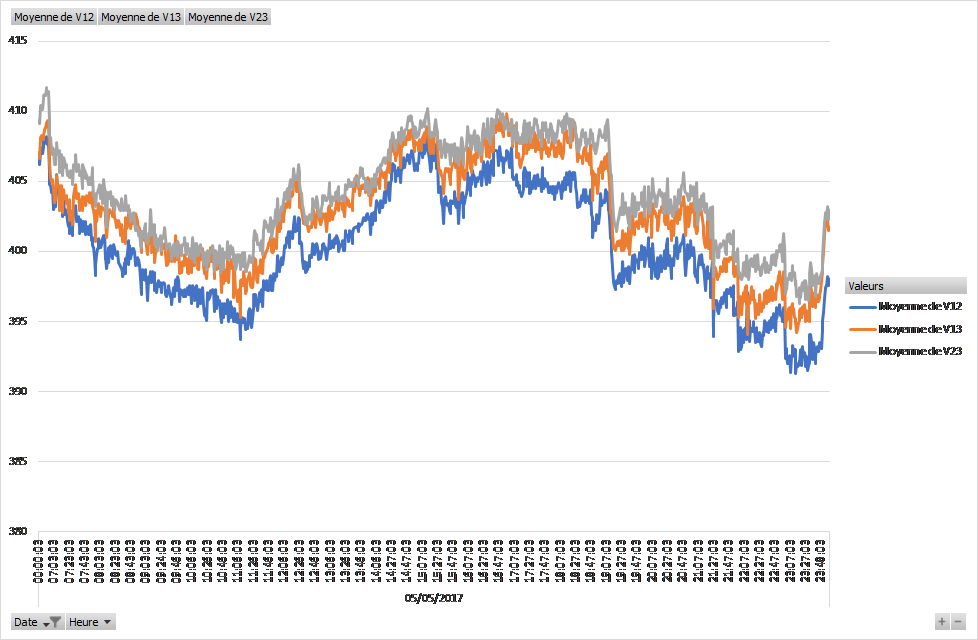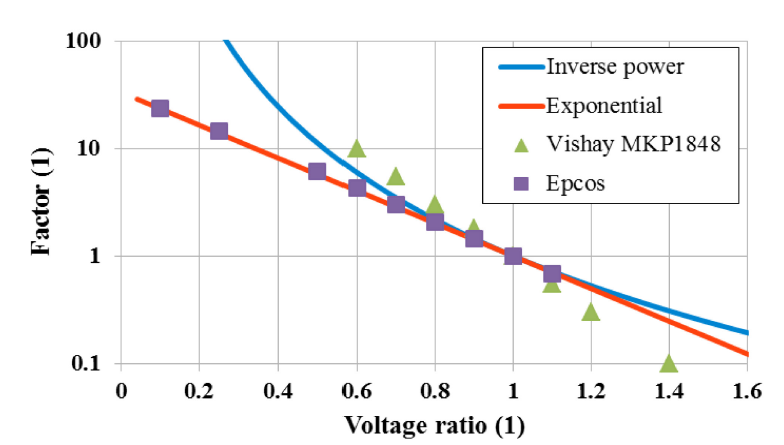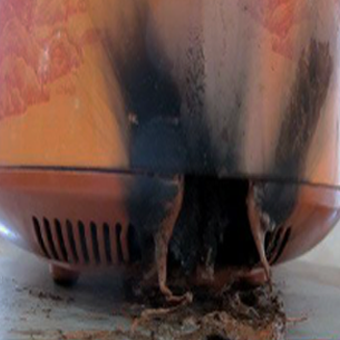The quality of manufacturing of your capacitor banks are not worse than before, but the environment has changed.
Three continuously growing characteristics of today’s networks have a significant impact on equipment reliability especially on capacitor banks: the supply voltage variation, the supply voltage level and harmonics. Consequences are briefly discussed below.
Power from intermittent renewable sources
 The massive introduction of power from renewable energy sources, intermittent in nature, in the low and medium voltages network has a significant impact on the voltage variation as illustrated here on the left showing records over 24H. Though the voltage level may be maintained within limits by means of equipment such as tap transformers, one must keep in mind that the reactive energy capacity of a capacitor is proportional to the square of the voltage. As example if one assumes a bank made of six equal steps of each 17%, one easily calculates that a voltage variation of 8% is equivalent to the obliteration or addition of a complete step. If the actual required reactive power is closed to a round number of steps, one understands how much the voltage variations will significantly increase the number of commutations even when the reactive load is constant. This growth of repetitive commutations will shorten the lifetime of the switches, recognised as the major failure with regular replacement as witnessed by several users.
The massive introduction of power from renewable energy sources, intermittent in nature, in the low and medium voltages network has a significant impact on the voltage variation as illustrated here on the left showing records over 24H. Though the voltage level may be maintained within limits by means of equipment such as tap transformers, one must keep in mind that the reactive energy capacity of a capacitor is proportional to the square of the voltage. As example if one assumes a bank made of six equal steps of each 17%, one easily calculates that a voltage variation of 8% is equivalent to the obliteration or addition of a complete step. If the actual required reactive power is closed to a round number of steps, one understands how much the voltage variations will significantly increase the number of commutations even when the reactive load is constant. This growth of repetitive commutations will shorten the lifetime of the switches, recognised as the major failure with regular replacement as witnessed by several users.
Distributed sources with bidirectional power flow
 The operation of networks with bi-directional power flow coming from multiple distributed power sources comes with an increase of the average voltage level of medium and low voltage networks as shown in multiple studies. Capacitor banks specifications integrate the voltage tolerance and thus are not directly destroyed by this change. However as illustrated in the figure nearby, the lifetime of a film capacitor is in the power 5 to 7 of the voltage level. In other words, an increase of ten percent of the voltage will reduce the lifetime by 38% to 51% depending on the manufacturer. Consequently, companies connected to the medium and low voltage network should expect an acceleration of the maintenance and replacement of their capacitor banks and should consider the actual conditions of their application.
The operation of networks with bi-directional power flow coming from multiple distributed power sources comes with an increase of the average voltage level of medium and low voltage networks as shown in multiple studies. Capacitor banks specifications integrate the voltage tolerance and thus are not directly destroyed by this change. However as illustrated in the figure nearby, the lifetime of a film capacitor is in the power 5 to 7 of the voltage level. In other words, an increase of ten percent of the voltage will reduce the lifetime by 38% to 51% depending on the manufacturer. Consequently, companies connected to the medium and low voltage network should expect an acceleration of the maintenance and replacement of their capacitor banks and should consider the actual conditions of their application.
Picture Source: CERN R.Gallay. http://cds.cern.ch/record/2038610
The growth of energy savings equipment
 The last major trend of network pollution relates to the exponential growth of energy savings equipment based on switch mode power electronics such as variable frequency drivers, computers, rectifiers and electronic ballasts. All those equipment (more or less equipped with filters and consequently of variable costs) produce high levels of harmonics by nature of the technology used. These harmonics can produce failures such as the one observed after five months in a textile factory in the picture nearby. Nowadays the problem is well identified and capacitor banks are equipped with detuning reactors. However, the latest remain mitigation solutions slowing down the ageing process. Further, the ratio of harmonic producing loads continue to grow. When those are above 40% of the load, active harmonic filters should be considered. When the load is powered by a local generator, power quality correction must be implemented for much lower levels as the generator may not be able to start when its operation is critical for the business.
The last major trend of network pollution relates to the exponential growth of energy savings equipment based on switch mode power electronics such as variable frequency drivers, computers, rectifiers and electronic ballasts. All those equipment (more or less equipped with filters and consequently of variable costs) produce high levels of harmonics by nature of the technology used. These harmonics can produce failures such as the one observed after five months in a textile factory in the picture nearby. Nowadays the problem is well identified and capacitor banks are equipped with detuning reactors. However, the latest remain mitigation solutions slowing down the ageing process. Further, the ratio of harmonic producing loads continue to grow. When those are above 40% of the load, active harmonic filters should be considered. When the load is powered by a local generator, power quality correction must be implemented for much lower levels as the generator may not be able to start when its operation is critical for the business.






